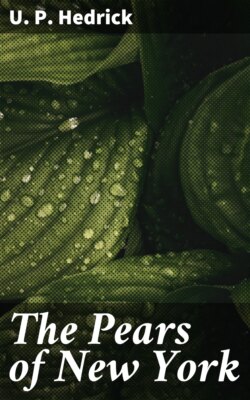Читать книгу The Pears of New York - U. P. Hedrick - Страница 41
На сайте Литреса книга снята с продажи.
BEURRÉ D’ARENBERG [26]
ОглавлениеTable of Contents
1. Trans. Lond. Hort. Soc. 5:406. 1824. 2. Lindley Guide Orch. Gard. 392. 1831. 3. Prince Pom. Man. 1:51. 1831. 4. Kenrick Am. Orch. 188. 1832. 5. Ibid. 156. 1841. 6. Gard. Chron. 716, fig. 2. 1844. 7. Downing Fr. Trees Am. 423, fig. 195. 1845. 8. Proc. Nat. Con. Fr. Gr. 51. 1848. 9. Hovey Fr. Am. 1:1, Pl. 1851. 10. Mass. Hort. Soc. Rpt. 93, Pl. 1852. 11. Mas Le Verger 1:161, fig. 79. 1866–73. 12. Hogg Fruit Man. 510. 1884.
Orpheline d’Enghien. 13. Ann. Pom. Belge 3:35, Pl. 1855. 14. Guide Prat. 108, 292. 1876.
In favorable locations this pear seems to possess all of the characters which constitute a first-class fruit; but, notwithstanding, although it has been in the country nearly a century, it is now scarcely to be found in the nurseries, and orchard trees are becoming rare. The fruits are distinguished by their refreshing, vinous taste and long-keeping qualities. Very often, however, they do not ripen in eastern America, and when not properly ripened the pears are highly acidulous and so astringent as to be almost intolerable to the taste. The frequency with which these poor fruits are borne, always on heavy, cold clays and in cold climates, coupled with rather small, short-lived trees, condemn the variety for most pear regions in the East. In the far West, the crop ripens better, and the pears are splendid winter fruits. The merits of the variety are so varying in New York that it is not now worth while attempting to bring it into new life.
Beurré d’Arenberg, in the opinion of some European writers, holds first place among the pears produced by French and Belgian pomologists. Unfortunately, Beurré d’Arenberg and Glou Morceau are often mistaken the one for the other. Beurré d’Arenberg was raised by Monseigneur Deschamps, Abbé of the Orphan Hospital, Enghien, Belgium. At about the same time, M. Noisette, a nurseryman of Paris, sent out Glou Morceau, which he had procured from the gardens of the Duc d’Arenberg, under the name Beurré d’Arenberg, so that there were two distinct varieties in cultivation under the same name. The true Beurré d’Arenberg of the Abbé Deschamps came to this country about 1827, having been sent over by Thomas Andrew Knight, President of the London Horticultural Society, to the Hon. John Lowell of Boston. The American Pomological Society recommended this variety for cultivation in 1848, but in 1871 the name disappeared from the Society’s catalog.
